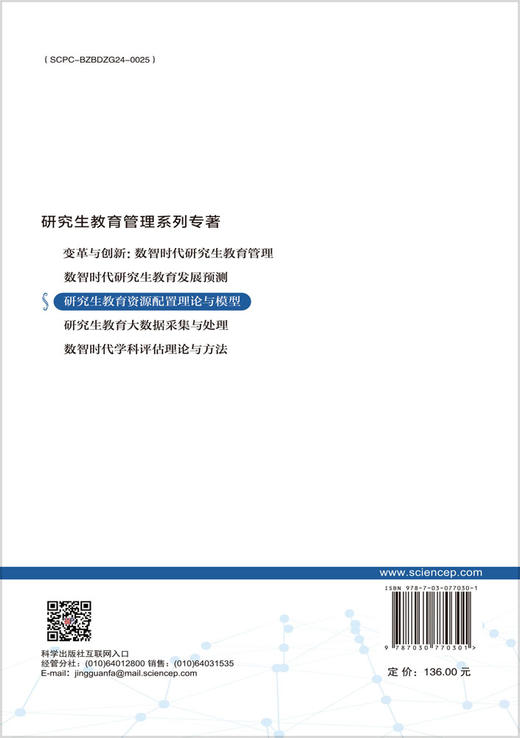商品详情
书名:研究生教育资源配置理论与模型
定价:136.0
ISBN:9787030770301
作者:李侃,屈少杰
版次:1
出版时间:2024-07
内容提要:
本书是一部探索研究生教育资源配置理论与模型研究的学术专著,其动机源自对于高等教育的责任与使命的思考,域变换理论是本学术专著的核心理论框架。本书共八章,融合古代先贤的思想精华,汇聚跨学科智慧,提出了研究生教育资源配置的域变换理论,分析了影响资源配置的多种因素和模式,构建了资源配置模型和评价指标体系,并通过实证研究为理论提供了实际验证。本书通过研究研究生教育资源配置模式,为我国高等教育事业的发展贡献一份微薄之力。
目录:
目录
第1章 绪论 1
1.1 研究生教育资源配置的内涵 1
1.2 国内外研究生教育资源配置的发展概述 4
1.3 研究生教育资源配置的相关理论 25
1.4 “互联网+”时代研究生教育资源配置面临的挑战 30
1.5 研究内容 37
1.6 本章小结 37
第2章 资源配置域变换理论 38
2.1 现有资源配置理论分析 38
2.2 域变换理论的相关定义 39
2.3 域变换理论主体 40
2.4 域变换理论影响因素 41
2.5 域变换模式 45
2.6 本章小结 52
第3章 “互联网+”时代研究生教育资源配置影响因素 53
3.1 “互联网+”时代研究生教育资源配置影响因素的新变化 53
3.2 研究生教育资源配置外部影响因素 57
3.3 研究生教育资源配置内部影响因素 67
3.4 本章小结 73
第4章 “互联网+”时代研究生教育资源配置模式 74
4.1 研究生教育资源配置目标 74
4.2 研究生教育资源配置主体 76
4.3 研究生教育资源配置的域变换机制 85
4.4 研究生教育资源配置的策略 97
4.5 研究生教育资源配置的域变换方式 105
4.6 本章小结 109
第5章 “互联网+”时代研究生教育资源配置模型 110
5.1 传统的资源配置方法 111
5.2 “互联网+”时代研究生教育资源的域嵌入 114
5.3 基于域变换理论的研究生教育资源配置模型 116
5.4 本章小结 121
第6章 “互联网+”时代研究生教育资源配置评价指标体系 122
6.1 “互联网+”时代研究生教育资源配置原则 122
6.2 研究生教育资源配置评价指标池 123
6.3 评价指标选择依据 127
6.4 “互联网+”时代研究生教育资源配置的评价指标 131
6.5 “互联网+”时代研究生教育资源配置的评价方法 136
6.6 本章小结 141
第7章 研究生招生规模实证研究 142
7.1 引言 142
7.2 研究生招生规模数据 142
7.3 基于嵌入的研究生招生规模数据预处理 150
7.4 基于蒙特卡罗的柔性指标选择 155
7.5 基于域变换的研究生招生规模变化预测与分析 159
7.6 本章小结 162
第8章 总结与展望 163
8.1 本书小结 163
8.2 未来展望 163
后记 166
Contents
Chapter 1 Introduction 1
1.1 Connotation of Resource Allocation in Graduate Education 1
1.2 Overview of the Development of Resource Allocation for Graduate Education at Home and Abroad 4
1.3 Relevant Theory of Resource Allocation in Graduate Education 25
1.4 Challenges to Postgraduate Education Resource Allocation in the Era of “Internet Plus” 30
1.5 Research Content 37
1.6 Summary of This Chapter 37
Chapter 2 Resource Allocation Domain Transformation Theory 38
2.1 Theoretical Analysis of Existing Resource Allocation 38
2.2 Definition of Domain Transformation Theory 39
2.3 Subject of Domain Transformation Theory 40
2.4 Factors Influencing Domain Transformation Theory 41
2.5 Domain Transformation Mode 45
2.6 Summary of This Chapter 52
Chapter 3 Factors Influencing Postgraduate Education Resource Allocation in the “Internet Plus” Era 53
3.1 New Changes in Influencing Factors of Graduate Education Resource Allocation in the Era of “Internet Plus” 53
3.2 External Influencing Factors of Graduate Education Resource Allocation 57
3.3 Internal Influencing Factors of Graduate Education Resource Allocation 67
3.4 Summary of This Chapter 73
Chapter 4 Postgraduate Education Resource Allocation Mode in the “Internet Plus” Era 74
4.1 Configuration Objectives of Resource Allocatton for Graduate Education 74
4.2 Main Body of Resource Allocation for Graduate Education 76
4.3 Domain Transformation Mechanism of Graduate Education Resource Allocation 85
4.4 Strategies for Allocation of Graduate Education Resources 97
4.5 Domain Transformation Methods for Allocation of Graduate Education Resources 105
4.6 Summary of This Chapter 109
Chapter 5 Postgraduate Education Resource Allocation Model in the “Internet Plus” Era 110
5.1 Traditional Resource Allocation Methods 111
5.2 Domain Embedding of Graduate Education Resources in the Era of“Internet Plus” 114
5.3 Model for Resource Allocation of Graduate Education Based on Domain Transformation Theory 116
5.4 Summary of This Chapter 121
Chapter 6 Evaluation System of Postgraduate Education Resource Allocation in the “Internet Plus” Era 122
6.1 Postgraduate Education Resource Allocation Principles in the Era of“Internet Plus” 122
6.2 Evaluation Index Pool for Graduate Education Resource Allocation 123
6.3 Evaluation Index Selection Basis 127
6.4 Evaluation Indicators of Graduate Education Resource Allocation in the Era of “Internet Plus” 131
6.5 Evaluation Methods for Graduate Education Resource Allocation in the Era of “Internet Plus” 136
6.6 Summary of This Chapter 141
Chapter 7 Empirical Study on the Scale of Graduate Enrollment 142
7.1 Introduction 142
7.2 Data on Graduate Enrollment Scale 142
7.3 Prepossessing of Graduate Enrollment Scale Data Based on Embedding 150
7.4 Selection of Flexibility Indicators Based on Monte Carlo 155
7.5 Prediction and Analysis of Changes in Graduate Enrollment Scale Based on Domain Transformation 159
7.6 Summary of This Chapter 162
Chapter 8 Summary and Outlook 163
8.1 Summary of This Book 163
8.2 Future Outlook 163
Postscript 166
定价:136.0
ISBN:9787030770301
作者:李侃,屈少杰
版次:1
出版时间:2024-07
内容提要:
本书是一部探索研究生教育资源配置理论与模型研究的学术专著,其动机源自对于高等教育的责任与使命的思考,域变换理论是本学术专著的核心理论框架。本书共八章,融合古代先贤的思想精华,汇聚跨学科智慧,提出了研究生教育资源配置的域变换理论,分析了影响资源配置的多种因素和模式,构建了资源配置模型和评价指标体系,并通过实证研究为理论提供了实际验证。本书通过研究研究生教育资源配置模式,为我国高等教育事业的发展贡献一份微薄之力。
目录:
目录
第1章 绪论 1
1.1 研究生教育资源配置的内涵 1
1.2 国内外研究生教育资源配置的发展概述 4
1.3 研究生教育资源配置的相关理论 25
1.4 “互联网+”时代研究生教育资源配置面临的挑战 30
1.5 研究内容 37
1.6 本章小结 37
第2章 资源配置域变换理论 38
2.1 现有资源配置理论分析 38
2.2 域变换理论的相关定义 39
2.3 域变换理论主体 40
2.4 域变换理论影响因素 41
2.5 域变换模式 45
2.6 本章小结 52
第3章 “互联网+”时代研究生教育资源配置影响因素 53
3.1 “互联网+”时代研究生教育资源配置影响因素的新变化 53
3.2 研究生教育资源配置外部影响因素 57
3.3 研究生教育资源配置内部影响因素 67
3.4 本章小结 73
第4章 “互联网+”时代研究生教育资源配置模式 74
4.1 研究生教育资源配置目标 74
4.2 研究生教育资源配置主体 76
4.3 研究生教育资源配置的域变换机制 85
4.4 研究生教育资源配置的策略 97
4.5 研究生教育资源配置的域变换方式 105
4.6 本章小结 109
第5章 “互联网+”时代研究生教育资源配置模型 110
5.1 传统的资源配置方法 111
5.2 “互联网+”时代研究生教育资源的域嵌入 114
5.3 基于域变换理论的研究生教育资源配置模型 116
5.4 本章小结 121
第6章 “互联网+”时代研究生教育资源配置评价指标体系 122
6.1 “互联网+”时代研究生教育资源配置原则 122
6.2 研究生教育资源配置评价指标池 123
6.3 评价指标选择依据 127
6.4 “互联网+”时代研究生教育资源配置的评价指标 131
6.5 “互联网+”时代研究生教育资源配置的评价方法 136
6.6 本章小结 141
第7章 研究生招生规模实证研究 142
7.1 引言 142
7.2 研究生招生规模数据 142
7.3 基于嵌入的研究生招生规模数据预处理 150
7.4 基于蒙特卡罗的柔性指标选择 155
7.5 基于域变换的研究生招生规模变化预测与分析 159
7.6 本章小结 162
第8章 总结与展望 163
8.1 本书小结 163
8.2 未来展望 163
后记 166
Contents
Chapter 1 Introduction 1
1.1 Connotation of Resource Allocation in Graduate Education 1
1.2 Overview of the Development of Resource Allocation for Graduate Education at Home and Abroad 4
1.3 Relevant Theory of Resource Allocation in Graduate Education 25
1.4 Challenges to Postgraduate Education Resource Allocation in the Era of “Internet Plus” 30
1.5 Research Content 37
1.6 Summary of This Chapter 37
Chapter 2 Resource Allocation Domain Transformation Theory 38
2.1 Theoretical Analysis of Existing Resource Allocation 38
2.2 Definition of Domain Transformation Theory 39
2.3 Subject of Domain Transformation Theory 40
2.4 Factors Influencing Domain Transformation Theory 41
2.5 Domain Transformation Mode 45
2.6 Summary of This Chapter 52
Chapter 3 Factors Influencing Postgraduate Education Resource Allocation in the “Internet Plus” Era 53
3.1 New Changes in Influencing Factors of Graduate Education Resource Allocation in the Era of “Internet Plus” 53
3.2 External Influencing Factors of Graduate Education Resource Allocation 57
3.3 Internal Influencing Factors of Graduate Education Resource Allocation 67
3.4 Summary of This Chapter 73
Chapter 4 Postgraduate Education Resource Allocation Mode in the “Internet Plus” Era 74
4.1 Configuration Objectives of Resource Allocatton for Graduate Education 74
4.2 Main Body of Resource Allocation for Graduate Education 76
4.3 Domain Transformation Mechanism of Graduate Education Resource Allocation 85
4.4 Strategies for Allocation of Graduate Education Resources 97
4.5 Domain Transformation Methods for Allocation of Graduate Education Resources 105
4.6 Summary of This Chapter 109
Chapter 5 Postgraduate Education Resource Allocation Model in the “Internet Plus” Era 110
5.1 Traditional Resource Allocation Methods 111
5.2 Domain Embedding of Graduate Education Resources in the Era of“Internet Plus” 114
5.3 Model for Resource Allocation of Graduate Education Based on Domain Transformation Theory 116
5.4 Summary of This Chapter 121
Chapter 6 Evaluation System of Postgraduate Education Resource Allocation in the “Internet Plus” Era 122
6.1 Postgraduate Education Resource Allocation Principles in the Era of“Internet Plus” 122
6.2 Evaluation Index Pool for Graduate Education Resource Allocation 123
6.3 Evaluation Index Selection Basis 127
6.4 Evaluation Indicators of Graduate Education Resource Allocation in the Era of “Internet Plus” 131
6.5 Evaluation Methods for Graduate Education Resource Allocation in the Era of “Internet Plus” 136
6.6 Summary of This Chapter 141
Chapter 7 Empirical Study on the Scale of Graduate Enrollment 142
7.1 Introduction 142
7.2 Data on Graduate Enrollment Scale 142
7.3 Prepossessing of Graduate Enrollment Scale Data Based on Embedding 150
7.4 Selection of Flexibility Indicators Based on Monte Carlo 155
7.5 Prediction and Analysis of Changes in Graduate Enrollment Scale Based on Domain Transformation 159
7.6 Summary of This Chapter 162
Chapter 8 Summary and Outlook 163
8.1 Summary of This Book 163
8.2 Future Outlook 163
Postscript 166
- 科学出版社旗舰店 (微信公众号认证)
- 科学出版社秉承多年来形成的“高层次、高水平、高质量”和“严肃、严密、严格”的优良传统与作风,始终坚持为科技创新服务、为传播与普及科学知识服务、为科学家和广大读者服务的宗旨。
- 扫描二维码,访问我们的微信店铺
- 随时随地的购物、客服咨询、查询订单和物流...












